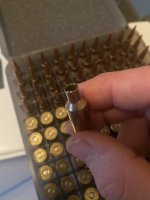So I use a Gerardi power Trimmer to chamfer and deburr , I also have a Lyman case prep station where I also put a little more of a chamfer and deburr on some of my cases , I noticed when I’m puttting my bullets into my cases that the ones I’ll do the extra chamfer and deburr , there’s not as much neck tension, so what I did is re-anneal those cases and the neck tension was back to normal so is it a bad thing to anneal twice when reloading and I think I’m just gonna stop the second chamfer and deburr because I think it’s not needed obviously, The reason I did the second chamfer and deburr was one of my calibers on my Girard power trimmer was not set up correctly.
Thanks guys and Happy New Year!!!!
Thanks guys and Happy New Year!!!!



